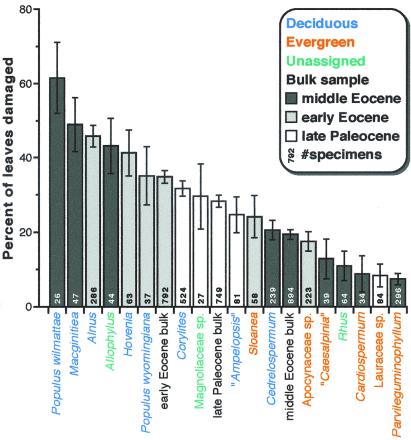Figure 2.
Herbivory frequency (percentage basis), coded by species, time period, and presumed category of leaf lifespan, for species with ≥25 specimens in individual samples and for all specimens in each of the three samples (bulk). Error bars indicate ±1σ of binomial error, based on the number of specimens (8). Only the generic or family name is given for plant hosts, except for congeneric species (see Tables 2 and 3, which are published as supplemental data, for nomenclature). Mean herbivory frequency is significantly higher for deciduous than for evergreen hosts (F[1,12] = 20.7, P < 0.001). The comparison is still significant at the 95% level at a cutoff of ≥20 specimens (F[1,16] = 4.36, P = 0.053). Even if Allophylus is coded as evergreen and Rhus as deciduous, significance remains (F[1,14] = 6.68, P = 0.022 at the 25-specimen cutoff). Deciduous means are higher than evergreens within each time period as well; these within-sample differences are significant in the two Eocene samples, but the number of species in the Paleocene is too low to support significance (Paleocene F[1,1] = 15.6, P = 0.158; early Eocene F[1,3] = 18.5, P = 0.023; middle Eocene F[1,4] = 9.37, P = 0.038). Average leaf area (mean natural log of mm2) from left to right: 7.40, 7.84, 7.40, 7.11, 7.27, 6.90, 7.35, 7.49, 8.17, 7.51, 7.54, 8.27, 5.35, 5.44, 6.93, 4.99, 6.20, 5.35, 7.42, 4.24.

